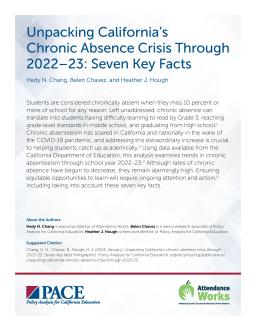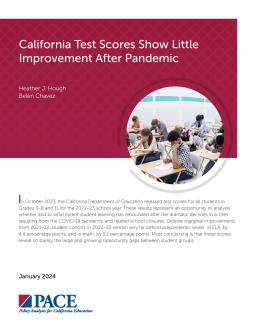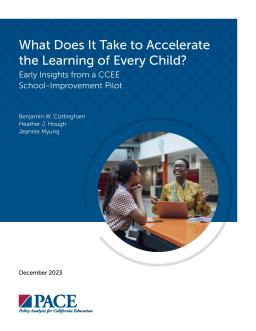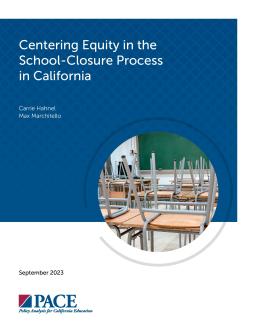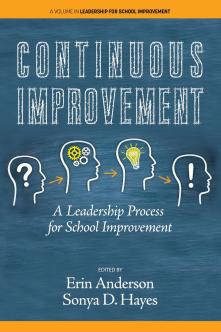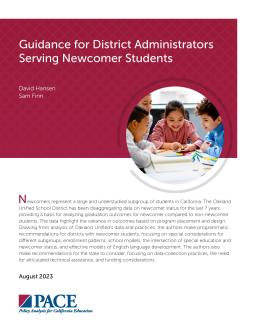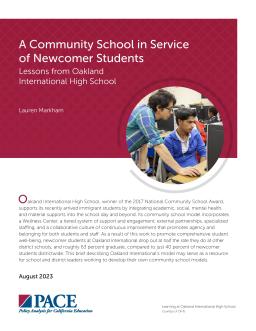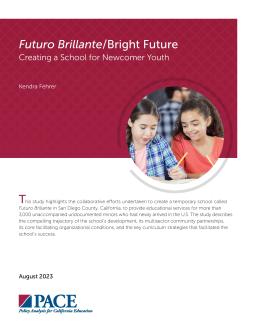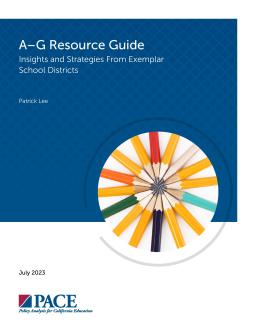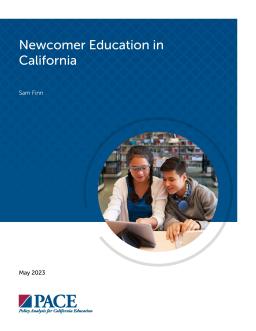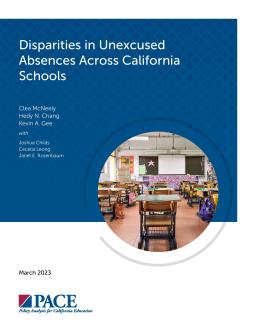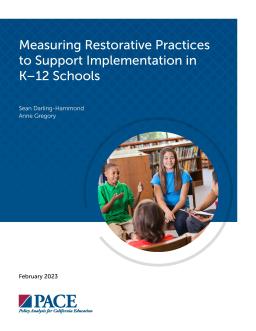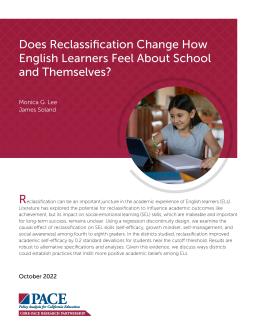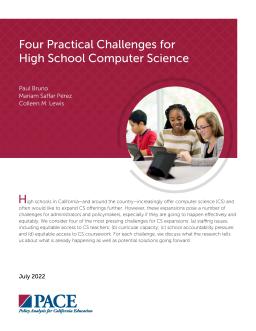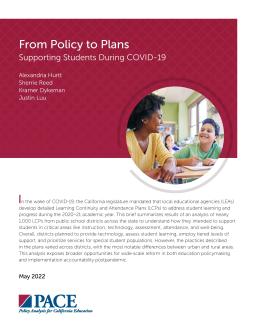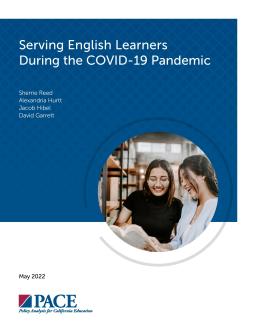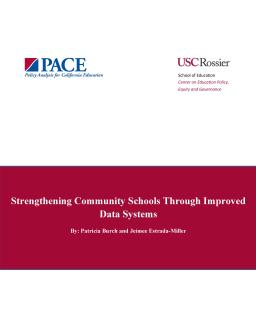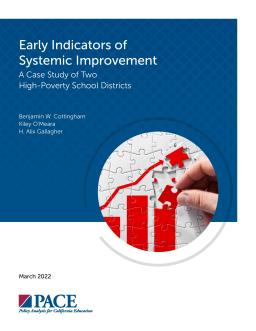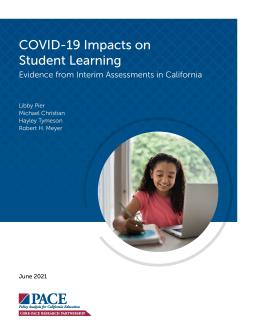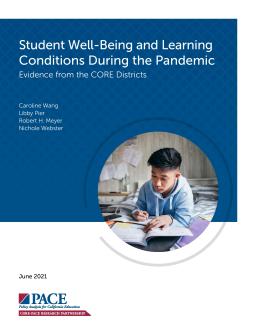Seven Key Facts
Published
Summary
Chronic absenteeism has soared in California and nationally in the wake of the COVID-19 pandemic, and addressing this extraordinary increase is crucial to helping students catch up academically. Using data available from the California Department of Education, this analysis examines trends in chronic absenteeism through school year 2022–23.3 Although rates of chronic absence have begun to decrease, they remain alarmingly high. Ensuring equitable opportunities to learn will require ongoing attention and action, including taking into account these seven key facts.
Published
Summary
In October 2023, the California Department of Education released test scores for all students in Grades 3–8 and 11 for the 2022–23 school year. These results represent an opportunity to analyze whether and to what extent student learning has rebounded after the dramatic declines in scores resulting from the COVID-19 pandemic and related school closures. Despite marginal improvements from 2021–22, student cohorts in 2022–23 remain very far behind prepandemic levels.
Early Insights from a CCEE School-Improvement Pilot
Published
Summary
Student achievement in California has not rebounded after the precipitous declines of the COVID-19 pandemic, with English language arts (ELA) and math scores remaining well below prepandemic levels. Student attendance has declined dramatically, and trauma and time away from school have led to mental health challenges, delays in social development, and behavioral issues among students. All too often, teachers work in isolation to create lesson plans and deliver instruction, with little instructional support, limited opportunities for collaboration, and unclear expectations.
Published
Summary
Declining student enrollment is leading to a loss of revenue in many California school districts. To address ongoing budget shortfalls, many districts have consolidated or shuttered schools,and others are contemplating doing so. A new report and working paper, summarized in this brief, explore the racial dimensions of school closures and how to address them.
Published
Summary
Enrollment in California public schools has been declining and is projected to fall even more steeply during the next decade. Because funding for school districts is largely based on average daily attendance rates, a decline in enrollment results in a loss of funding. To address budget shortfalls and align services with student counts, many districts have consolidated or closed schools, or they are contemplating doing so.
Published
Summary
This study investigates racial disparities in school closures both within California and nationally. Findings highlight an alarming pattern: Schools enrolling higher proportions of Black students are at significantly increased risk of closure relative to those enrolling fewer Black students, a pattern that is more pronounced in California than elsewhere in the United States. The findings underscore that school closures in California and elsewhere reflect racial inequalities that require adequate policymaking to ensure equitable and fair school-closure proceedings.
Improvement Team Leads’ Perspectives on Fitting Improvement Work to Their Sites
Published
Summary
This chapter in an edited book focuses on the work of two improvement network hubs in California as they tried to support participating districts and schools to improve the proportion of students “on-track” for post-secondary success. California has a particular stake in figuring out how to support districts in consistently using continuous improvement (CI) to achieve measurable gains in student outcomes because state policy (e.g., Local Control Funding Formula, California’s Every Student Succeeds Act Plan) prescribes CI as the approach to improvement in its accountability system.
Published
Summary
Newcomers represent a large and understudied subgroup of students in California. The Oakland Unified School District has been disaggregating data on newcomer status for the last 7 years, providing a basis for analyzing graduation outcomes for newcomer compared to non-newcomer students. The data highlight the variance in outcomes based on program placement and design. Drawing from analysis of Oakland Unified’s data and practices, the authors make programmatic recommendations for districts with newcomer students.
Lessons From Oakland International High School
Published
Summary
Oakland International High School, winner of the 2017 National Community School Award, supports its recently arrived immigrant students by integrating academic, social, mental health,and material supports into the school day and beyond. Its community school model incorporates a Wellness Center, a tiered system of support and engagement, external partnerships, specialized staffing, and a collaborative culture of continuous improvement that promotes agency and belonging for both students and staff.
Promising Practices
Published
Summary
This case study identifies promising practices for newcomer education implemented in San Juan Unified School District (SJUSD), one of 12 local educational agencies (LEAs) funded under the California Newcomer Education and Well-Being (CalNEW) project between 2018 and 2021. This report was developed through a partnership between PACE and the Center for Equity for English Learners (CEEL) at Loyola Marymount University (LMU).
Creating a School for Newcomer Youth
Published
Summary
This study highlights the collaborative efforts undertaken to create a temporary school called Futuro Brillante in San Diego County, California, to provide educational services for more than 3,000 unaccompanied undocumented minors who had newly arrived in the U.S. The study describes the compelling trajectory of the school’s development, its multisector community partnerships, its core facilitating organizational conditions, and the key curriculum strategies that facilitated the school’s success.
Insights and Strategies From Exemplar School Districts
Published
Summary
This resource guide addresses a key problem that many district and school leaders in California face: how to increase student enrollment and success in A–G courses to reduce equity gaps in college eligibility. Developed from a qualitative research study that examined the policies and practices of nine school districts in California with A–G completion rates surpassing the overall statewide rate, the guide presents strategies, tools, and resources to address challenges with A–G course alignment, counseling, and scheduling.
Published
Summary
Every year, 150k-200k new immigrant students in California need specialized instruction and social services to succeed, but many districts struggle to provide them, resulting in dropouts and poor outcomes. Inaccessible instruction and lack of basic necessities hinder progress. The PACE report recommends developing data, instruction, and social support services to improve newcomer outcomes in California.
Published
Summary
This report finds that improving school attendance is crucial, especially with the increase in chronic absence. Data on unexcused absences should be used to create a more preventive, problem-solving, and equitable response to poor attendance. Labeling absences as unexcused affects how students and families are treated and can lead to punitive measures that may not improve attendance. Overuse of the unexcused-absence label could undermine efforts to partner with students and families to improve attendance.
CORE’s Approach
Published
Summary
Educators face a dilemma of staying up-to-date with evidence-based practices while dealing with superficial ideas. Continuous improvement methods can help in testing new ideas but if seen as add-ons, they may not yield sustained improvement. This brief describes the CORE Districts’ five-driver model that deepens educators’ ownership and sustains improvement over time.
Published
Summary
This report discusses the implementation challenges of restorative practices (RPs) in schools, which have the potential to reduce the use of exclusionary discipline and improve school climates. However, schools often struggle with selective adoption, and there is a need to measure the extent to which teachers are using and students are experiencing RPs. The report provides guidance on how to measure RP implementation and why it is essential for achieving the intended impacts, including decreasing discipline, reducing racial disparities, and improving academic achievement.
A Summary Brief
Published
Summary
This brief outlines findings from a study that examines the English proficiency levels and growth of newcomer English learner students in comparison to their non-newcomer peers. It was found that while newcomer students tend to have lower initial English proficiency levels, their English proficiency develops quickly. There is, however, wide variation in newcomer English level and growth patterns, and schools play an important role in fostering growth. Additionally, newcomers enter school at earlier stages of English proficiency than non-newcomer English learner peers.
Published
Summary
This study explores the impact of reclassification on social-emotional learning skills (SEL) of English learners (ELs) in grades 4 to 8. Using a regression discontinuity design, the study found that reclassification improved academic self-efficacy by 0.2 standard deviations for students near the cutoff threshold. The results suggest that reclassification can positively influence the academic beliefs of ELs and the authors provide recommendations for districts to create practices that foster such positive beliefs.
Published
Summary
California high schools face challenges in expanding computer science (CS) programs due to staffing issues, curricular capacity, school accountability pressure, and equitable access to CS coursework. This report discusses potential solutions based on research for each challenge.
Supporting Students During COVID-19
Published
Summary
An analysis of Learning Continuity and Attendance Plans (LCPs) developed by local educational agencies in California during the 2020-21 academic year showed variations in practices across districts, particularly between urban and rural areas. While districts planned to provide technology, assess student learning, and offer tiered levels of support, broader opportunities for reform and implementation accountability in education policymaking are needed post-pandemic.
Published
Summary
The COVID-19 pandemic has made it difficult for English learners (ELs) to receive the services and support they need for academic success. This report highlights how K–12 public school districts planned to support ELs during the pandemic. While many districts communicated plans to assess student progress and provide services for ELs, details on the sufficiency of these plans were lacking. The legislation mandating the plans did not include measures for adherence or monitoring student outcomes, leaving questions about the actual strategies implemented by districts and how ELs were affected.
Published
Summary
Community schools are gaining attention as a promising solution for students from low-income families who have suffered economic trauma during the COVID-19 pandemic. Policymakers are investing in their expansion, and effective use of data will be crucial. This report discusses findings of a research project led by the Los Angeles County Office of Education and the USC Center on Education, Policy, Equity, and Governance and provides recommendations for implementing a data system to address community-specific needs.
A Case Study of Two High-Poverty School Districts
Published
Summary
A report examines two CA districts that have shifted their structures, policies, and culture to improve student outcomes. Both districts worked with California Education Partners to refine their continuous improvement approach and spread practices. PACE identified three key lessons for leading impactful improvement efforts: anchor work in outcome measures, invest in an aligned system of instructional learning, and use cross-role and cross-site structures. These lessons contributed to positive trends for student achievement, empowered practitioners, and built internal capacity for improvement.
Evidence From Interim Assessments in California
Published
Summary
At the first anniversary of school closures due to COVID-19, nearly half of the K–12 students in the U.S. were attending schools that were either fully remote or offering hybrid instruction, with more than 70 percent of California students attending schools remotely. For this reason, continued efforts to unpack the effects of COVID-19 on student outcomes are especially important for California students, who may be experiencing larger-than-average effects of continued school closures relative to the nation overall.
Evidence from the CORE Districts
Published
Summary
The CORE Districts in California conducted a survey to measure K-12 students’ social-emotional well-being during the pandemic. Results indicate that students’ personal and interpersonal well-being rated lower than their learning environments. Interpersonal well-being was most correlated with academic achievement. Home/online learning environment improved, but Grades 5-12 students reported not liking school as much in winter 2020-21. Stakeholders should focus on meeting the pressing needs of each group of students.
